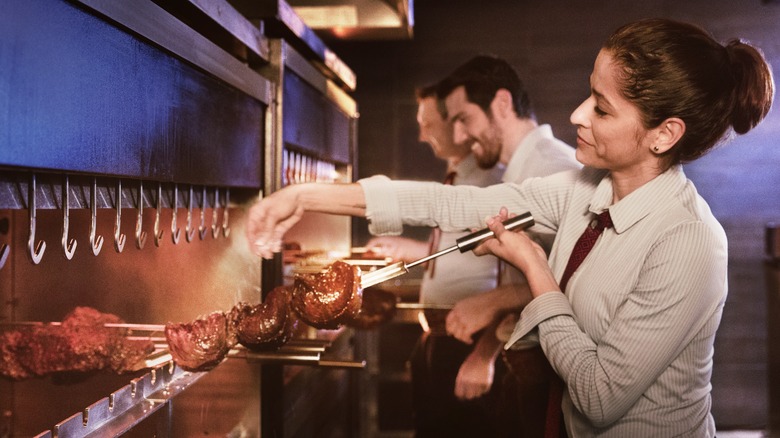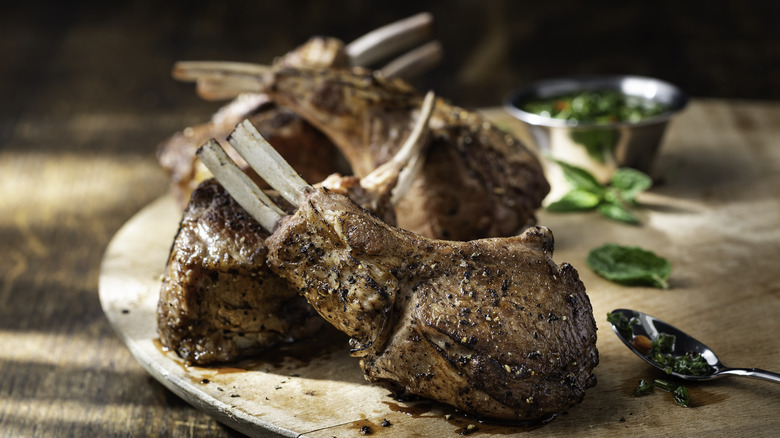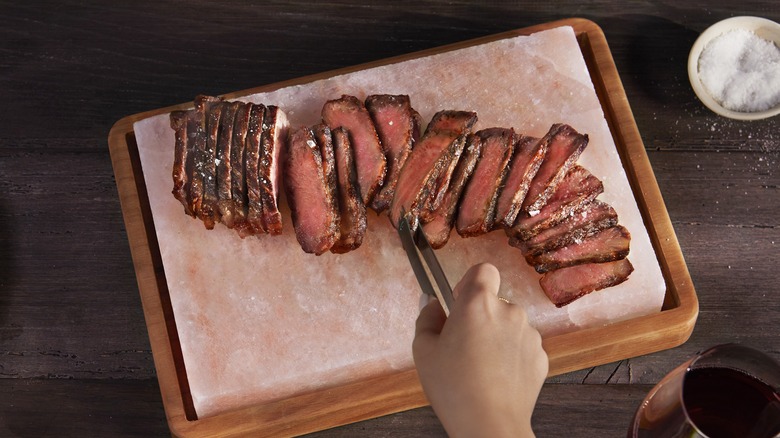What Really Makes Fogo De Chão's Meat So Delicious
The United States is certainly a pioneer when it comes to developing new and innovative forms of gluttony. After all, we gave the world the endless abundance that is Golden Corral, and not one but 17 different chains of all-you-can-eat buffets. But there's one area of eating to excess where we've been squarely bested: the Brazilian rodizio steakhouse, where finely trained gauchos wander a dining room with skewers of savory meats and cut off as much as you want for as long as you like.
In the U.S., no place does this better than Fogo de Chão, an upscale rodizio restaurant with locations nationwide. Its meat just tastes ... different than other Brazilian steakhouses, offering richer, stronger, and more intricate flavors. So why does Fogo de Chão's meat taste so darned good? We headed to its newest location in Fort Lauderdale, Florida, to find out and got a behind-the-scenes tour with General Manager Wandering Oliveira and Southeast Area Director Rudimar Bonfada. They hipped us to the whole process, from picking the right meats to aging, seasoning, and serving them.
Fogo de Chão's name and cooking style come from Brazil
If you're not up on your Portuguese, literally translated Fogo de Chão means "fire on the ground," an alluring vision that might give you flashbacks to high school bonfires where you roasted Ball Park hot dogs and drank really cheap beer. To Brazilians, it means something entirely different though. It's a cooking style special to their country that has spawned an entire category of restaurants in North America.
"You see the fire here on a very high-level grill," Fogo de Chão Fort Lauderdale General Manager Wandering Oliveira said. "But back in the day, even back home, the fire is literally on the ground with sticks and skewers around with [meat,] and you carve, and you serve, and you eat right there." Oliveira further explained that Fogo de Chão's gauchos understand this tradition and take great pride in continuing it inside the restaurant.
All the meat at Fogo de Chão is USDA Choice or better
The flavor of the meat customers get sliced delicately onto their plates begins with the raw material: the beef. Each of Fogo de Chão's cuts is rated USDA Choice or higher, according to both Bonifada and Oliveira, a sure sign of quality that ensures every steak that glides by you is some of the best beef in the country. So what does USDA Choice mean, exactly?
Well, according to the U.S. Department of Agriculture's website, beef is graded in order to make business transactions easier, so purchasers know the quality of beef they're paying for before it shows up at the door. USDA inspectors visit slaughterhouses and packing facilities to evaluate the product, rating beef as prime, choice, or select. Prime is the top grade you'd find at places like Morton's The Steakhouse and Red the Steakhouse. Next up is choice, which USDA describes as still a very high-quality cut, only with "less marbling than prime." Select is the lowest grade, and though still very good, it has the least marbling and is the leanest of the three. Beyond that, producers make ungraded and commercial beef, which are typically store-brand cuts.
The meat is aged in-house for 21 days
Once the meat is selected, it arrives at Fogo de Chão and is placed in refrigerated storage. Well, most of it is, but we'll get to the dry-aging process later. During our behind-the-scenes look at Fogo de Chão, Oliveira showed us the boxes upon boxes of steaks sitting in the prep room, with deliveries he says arrive two to three times a week. Fogo de Chão then ages the meat for 21 days -– or about three weeks — to enhance and concentrate its flavor before it's prepped for the grill.
Oliveira explained that the amount of beef his restaurant orders is based on expected reservations and how many cuts each restaurant goes through. It's then placed in rotating storage so the steaks that have been aged the longest are near the front. This ensures every steak that's served out on the restaurant floor has been properly aged, but never left in longer than it should be. "The rotation of the meat is important," says Fogo de Chão Southeast Regional Director Rudimar Bonfada. "When it comes in, we make sure to do a quality check ... and make sure no bag goes unturned."
The process of cooking the meat starts early in the morning
Once a steak has been properly aged, gauchos come early in the morning to begin prepping it for the day. This prep work includes marinating stuff like chicken and lamb, putting meat on skewers, wrapping certain cuts in bacon, and beginning the cooking process for cuts that take longer. Most Fogo de Chao locations have gauchos working in two shifts, and according to Oliveira they work in teams to ensure the meat is perfect and everything runs smoothly. Each team of gauchos is responsible for a specific cut of meat, whether that's picanha, filet mignon, bacon-wrapped chicken, or anything else. The morning teammate generally gets everything ready, and the evening teammate serves.
"[Gauchos] that come in in the morning, they're more responsible to prepare," Fogo de Chão Ft. Lauderdale General Manager Wandering Oliveira told us. "We know our reservations ... how many skewers we gotta have. So the person that is gonna come for the evening half, he'll be all set up because his partner will [have] made sure that everything was nice on stage four."
Fogo de Chão uses lump charcoal on a specially designed grill
Though rodizio originates from a style of cooking that was simply lighting a fire on the ground, Fogo de Chão has elevated the experience by utilizing a special grill and specific charcoal. According to Fogo de Chão Southeast Regional Director Rudimar Bonfada, each restaurant uses a special lump charcoal that ensures the temperature is right for the proper cooking of the steaks. "Where we cook the steaks is a little hotter than where we cook other cuts [of meat]," says Bonfada. "All our beef cuts, you want to sear the outside, then you elevate to a higher place on the grill where it won't be so hot, and from there it continues to make that steak more tender before we serve."
The grill is a multi-level racked grill with fire on the bottom, where longer cooking steaks are placed on the top and shorter cooking ones on the bottom. The grill used in the Ft. Lauderdale location is called a Peninsula Grill, according to General Manager Wandering Oliveira. It protrudes out from the steak display case and kitchen giving guests a chance to watch their meat cook while they peruse the salad bar.
Meats are rotated on the grill by sense and feel
Fogo de Chão puts their gauchos through some serious training, and while Ft. Lauderdale General Manager Wandering Oliveira says they have some guidelines for how long certain cuts should sit over the fire, the meat preparation is more an art than a science. So the gauchos, who are responsible for cooking the meat as well as serving it, operate more on sense and feel than on a set time that something needs to be cooked. It's a little like your dad when he cooked steaks in the backyard: Did he need a timer? Of course not. So it reasons the pros at Fogo don't either.
One might think slicing beef for hungry guests and cooking meat would be a tough balancing act. But Oliveira says the gauchos have it mastered. "Sometimes [it] can be tricky, right?" he asks rhetorically. "Because fire is there and it's hot. So if you don't pay attention, if you're not on top of your meat ... you can burn it. ... But that doesn't happen. [The gauchos], they're really proud of what they do and they take accountability for it."
Fogo de Chão offers bacon wrapped cuts
You could probably wrap bacon around a piece of rotting driftwood and it would taste delicious. Fogo de Chão understands this, and in addition to its regular selection of fire-grilled meats also serves a number of items wrapped in bacon which according to Fogo de Chão's website, is hardwood smoked and honey cured. This begins with bacon-wrapped chicken breasts, cooked high on the peninsula grill so the bacon juices have time to saturate the meat.
Fogo de Chão also offers Medalhoes con Bacon described on the menu simply as steak or chicken wrapped in bacon. Depending on the night, Fogo de Chão will also wrap several of its steaks in bacon, though Ft. Lauderdale General Manager Wandering Oliveira says which cut gets the bacon treatment changes regularly. On the night we stopped in the gauchos were roaming with bacon-wrapped filet mignon which tasted exactly as decadent as it sounds.
A few cuts of meat are switched out each season
Fogo de Chão keeps a consistent lineup of steaks, spelled out easily on its website so you can start salivating before you even make a reservation. Those include some standards you already know and love like filet mignon and porterhouse. But also some special Brazilian steak cuts like the iconic picanha, the circular-grained top sirloin that's the prime part of the cut, sliced extra then at the table. You'll also find beef ancho, which is essentially a bone-in ribeye, and fraldinha, which is a heavily marbled bottom sirloin popular in southern Brazil.
But unless you're getting rodizio every week, you'll likely see at least a few things different every time you go to Fogo de Chão. Yes, the salad bar changes up its offerings, but Fogo de Chão Ft. Lauderdale General Manager Wandering Oliveira says they tweak some of the meats by season too. "We will add a couple here and there for the season," he says. "We might bring in a different cut of ribeye ... or a porterhouse. We always stick with our main core means, but every season we try to bring something different."
Some of the cuts are also dry-aged
As we mentioned earlier, most of Fogo de Chão's steaks are aged for 21 days before they get out of their cases and onto the grill. But take a look at some of the meat display cases around a restaurant and you'll see a special selection of steaks being dry-aged too. This is Fogo de Chão's eye-catching dry-aged tomahawk ancho, which according to the restaurant's website is a 36 oz long bone rib eye dry-aged for a minimum of 42 days.
Now, you've probably heard the term "dry-aged" thrown around a lot, and much like terms such as "farm-to-table" and "hand crafted" aren't sure what it means, but assume it's something good. Unlike those other terms, though, dry aging is pretty specific, and has some serious science behind it. According to Fogo de Chão Southeast Area Director Rudimar Bonfada, dry aging involves storing steaks in a temperature and humidity-controlled locker to dry the steaks, yielding about 30% less meat than when you started due to evaporation of moisture. This concentrates the flavors, making them more robust. At the same time, enzymes begin breaking down the meat, creating a more tender cut as well.
Most of the beef is sourced from the American Midwest
While it might reason that a Brazilian steakhouse would source it's beef from, ya know, Brazil, Fogo de Chão's supply chain carbon footprint isn't that big. According to Southeast Area Director Rudimar Bonfada, all of Fogo de Chao's beef comes from the good old' U.S. of A., sourced from the heart of cattle country in the great Midwest. While he wouldn't elaborate on which states specifically, it's still comforting to know the beef comes from relatively close by.
"We source our beef mostly from suppliers who are leaders in sustainable business practice," he told Mashed in an exclusive interview. "Starting with the suppliers we work with, [who are] committed to serving the most wholesome, safest food." Again he did not elaborate on which, "sustainable business practices" he was referring to. But minimizing fuel and transportation costs in sourcing beef is always a good first step.
The gauchos go through a lot of training before they can cook the meat
Most of what an average Fogo de Chão guest sees of the restaurant's gauchos is their skillful slicing of steaming cuts of fresh beef, and their intricate explanation of what each steak is. But their job is far more than that. Two shifts of gauchos work every day the restaurant is open, with assigned pairs responsible for specific cuts of meat. So, for example, if one pair is assigned bacon-wrapped chicken, the early gaucho will spend most of his shift prepping and skewering the meat, possibly putting the first few skewers on the grill. The later gaucho will be responsible for cooking, watching, and serving the meat during dinner.
While this might sound simple, it involves an intense amount of training and expertise. The training lasts for about a month, explained Oliveira. "It's paramount to them because [it's all about] the timing. ... We wanna show them in the beginning of the training how the meat's supposed to look ... and the temperature of well done versus medium well." Oliveira later said, "I have some really proud gauchos here that love to teach and they know the process."
The meat is only flavored with rock sea salt
With such flavorful meat, some might assume that Fogo de Chão has a proprietary spice blend it puts on all its steaks to make them taste so delicious. This is not at all the case. The secret to Fogo de Chão's great flavor: Simple rock salt. Seriously, during our entire behind-the-scenes tour all we saw put on the meat was rock sea salt, a simple-yet-effective seasoning that brings out all the wonders of what Fogo de Chão grills. "We get questions a lot about what we use in our meat," says Ft. Lauderdale General Manager Wandering Oliveira. "People get surprised a lot with the answer that we just use sea salt."
Of course, it's not a reckless Salt Bae sprinkling of rock salt that makes the meat so good. How it's applied, and how much, is also part of gaucho training, and though relatively simple it is of utmost importance. "Our gauchos go through such a rigorous training, even how to salt the meat on the grill," says Southeast Area Director Rudimer Bonfada. "We eye it. Once the gauchos get in the habitual consistency of doing this every day ... it's all done by eye. They develop such an expertise to get to that level."
Fogo de Chão uses beer, brandy, and spices to marinate its chicken
While the steaks can hold their own with just a sprinkling of sea salt, other meats need a little more love to get them up to Fogo de Chão standards. This starts with its trademark frango, a chicken leg served on a skewer. Before the chicken gets the full rodizio treatment, though, it's marinated for hours in a special marinade that Fogo de Chão was surprisingly open about disclosing.
According to Southeast Area Director Rudimer Bonfada, the marinade Fogo de Chão uses on its chicken is fairly simple. It's a mixture of beer, brandy, paprika, garlic, lemon, onion, and pepper. "We use the onion and pepper to enhance the flavor of the meat," he told Mashed in an exclusive interview. "The beer and brandy help the meat absorb the flavor, [then] we marinate the chicken for 24-48 hours before we serve [it]." The same marinade is also used in the Medalhoes com bacon — regular chicken pieces wrapped in bacon.
The lamb is marinated with a healthy amount of mint and white wine
Steak is the main attraction at Fogo de Chão, to be sure. But guests might be well served to check out some of the other meats the restaurant offers. Roving the dining room, you'll also see pork chops, pork rib, pork loin, and sausages, each grilled with the same attention to detail and meticulous care as the trademark steaks.
One can't-miss item circulating on skewers is Fogo de Chão's lamb chops and prime lamb picanha. Both are marinated in a recipe completely different from the one the restaurant uses for chicken, this one is made up of white wine, lemon, and epic amounts of mint. The result is a crisp, citrusy bite that contrasts the richness of the lamb. The mint gives it an herbal finish that makes the chops taste almost like a savory tea, a flavor you likely won't find on menus elsewhere.
The meat is served fresh off the fire
Logistically, walking around with an entire tomahawk on a skewer would be a little awkward. That's why Fogo de Chão offers an entire menu of specialty steaks that are even more flavorful than the stuff the gauchos bring by. The aforementioned dry-aged tomahawk is one of the more popular from this supplemental (i.e. extra cost) menu, offering an exceptionally flavorful option for those who want something extra.
Also on the menu are a couple of American wagyu cuts — an ancho and a New York strip. For the unfamiliar, Wagyu is a term that originally referred to any cattle originating from Japan, according to Wagyu.org. Only four breeds in Japan are considered Wagyu today, considered to have superior marbling and flavor. American ranchers began importing Wagyu cattle in the 1970s, and today you can find both American and Japanese wagyu beef on menus. Fogo de Chão's offerings are served sizzling on a salt block, which adds to the flavor and flair whenever one is ordered.















